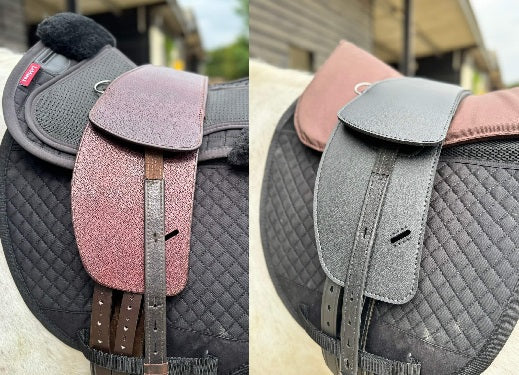
Leather vs. Synthetic Total Contact Saddle: Which One is Right for You?
Partager
Choosing the right saddle is a critical decision for every rider. Whether you're focused on performance, horse comfort, or practicality, a Total Contact Saddle is always the right choice, but thee debate between leather saddles like our Classic or Premium Total Contact Saddle and synthetic saddles like our ever popular Synthetic (Vegan) Total Contact Saddle is worth exploring. Each option has its advantages and drawbacks, and your choice ultimately depends on your needs, budget, and ridden activity. Let’s dive into the pros and cons of both leather and synthetic saddles to help you make an informed decision.
Leather Saddles: Timeless Quality and Comfort
✅ Pros

- Superior Comfort & Fit – Leather treeless saddles mold to the rider’s and horse’s shape over time, providing a customized fit.
- Durability & Longevity – With proper care, a high-quality leather treeless saddle can last decades, making it a worthwhile investment.
- Classic Aesthetic – Leather saddles have a traditional, polished look that is favored in disciplines like dressage, show jumping, and hunting.
- High Resale Value – Unlike synthetic saddles, premium leather models retain value and can be resold at a good price.
-
Repairability – Leather can be reconditioned, restitched, and repaired, allowing for extended use.
❌ Cons
- Higher Cost – Quality leather saddles, treed or treeless, are more expensive upfront, requiring a significantly higher financial commitment.
- Maintenance-Heavy – Regular cleaning and conditioning are required to prevent cracking, mold, and wear.
- Heavier Weight – It is a minimal difference, but perhaps worth mentioning. Our leather saddles are slighty heavier than synthetic options, which can be a factor for endurance riders.
- Less Resistance to Water & Mud – Exposure to moisture can damage leather, requiring extra care in wet conditions.
Synthetic Saddles: Lightweight and Low-Maintenance
✅ Pros

- Affordable – Our treeless synthetic saddles are budget-friendly, making them accessible to beginners and casual riders, as well as those curiour about the Total Contact Saddle (or treeless saddles in general) and wanting to give them a try.
- Lightweight – They are slightly lighter than leather saddles, further reducing strain on the horse, especially for long rides.
- Easy to Clean – No need for conditioners—synthetic saddles can be wiped down with a synthetic cleaner and some water.
- Weather-Resistant – Synthetic materials handle moisture well, making them ideal for humid or wet conditions and climates.
- Vegan-Friendly Option – For those avoiding animal products, synthetic saddles provide a cruelty-free alternative.
❌ Cons
- Less Comfortable Over Time – Unlike leather, synthetic saddles will not mold as well to the rider and horse, which means they always retain a certain rigidity.
- Shorter Lifespan – While durable, synthetic saddles do not last as long as well-maintained leather saddles.
- Can Feel Less Traditional – Some equestrians prefer the rich look and feel of leather, especially in professional or show environments.
The Verdict: Which One Should You Choose?
The decision between leather and synthetic saddles depends on your priorities:
- If you value comfort, longevity, and tradition, a leather saddle may be worth the investment.
- If you prefer affordability, low maintenance, and lightweight designs, a synthetic saddle is a great choice.
Regardless of your choice, proper care and fit are the most important factors for ensuring a comfortable ride for both you and your horse, which is always a given with a Total Contact Saddle!
Do you have a preferred saddle type? I'd love to hear your thoughts!

